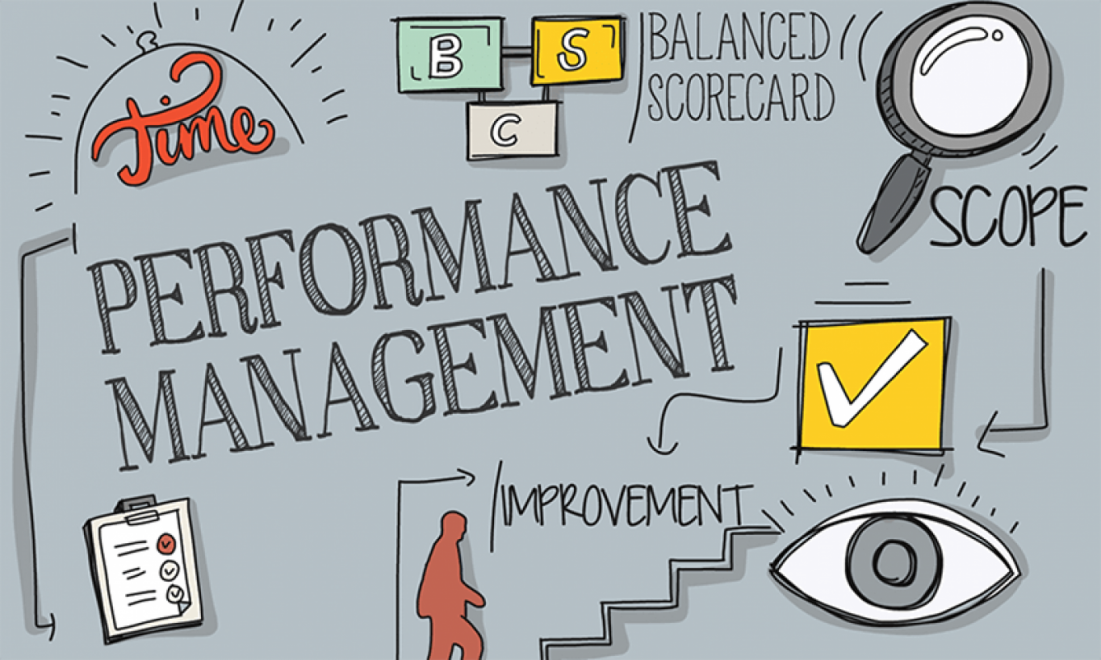What is a performance management system?
The efficiency management system is a tool to track employee productivity. It measures employee performance by certain key indicators according to the company’s goals.
PMS allows you to set strategic goals for each specialist in your team and track key performance indicators. This allows businesses to set up a team with reference goals that help them develop and achieve results in general.
Consistency and transparency are key to optimizing the efficiency management process.
Performance management is a continuous process of increasing efficiency by setting individual and team goals that meet the organization’s strategic goals, planning effectiveness to achieve goals, reviewing and assessing progress, and developing people’s knowledge, skills, and abilities.
Thus, performance management should combine a number of different integrated measures to form a constant cycle.
That’s why people created PMS to close the HR management issue and do it with objective evaluation.
The main benefits of the performance management system
Any company, regardless of industry or size, will benefit from an using effective management system.
- Increase efficiency of the training process of employees
The assessment may identify employees who need training and not all of them will be recent hires. Usually, it is assumed that when an employee has completed a normal sequence of studies, he or she is training. But this is not always true.
Whether your employees need to brush up on a certain skill or simply get up to speed with new trends for their role. Performance management and regular reviews can help to identify any shortcomings or future training requirements.
- Assistance in determining a specific employee's productivity or absence of productivity
Finally, employees who are too weak can be seen with greater confidence in the evaluation system. And this gives more arguments if you have long planned someone to dismiss, but not weigh up.
Now you can rely on a real assessment of the skills of each employee, including the weak employees you think should be dismissed, but concrete facts are not enough.
Now it is possible to argue and assess the effectiveness, to operate concrete indicators with the help of PMS.
- Helps to find talents in your team
Regular reviews are a great way to better understand the productivity of your employees and their growth opportunities in the company.
All employees will go through the same process of reviewing the results. This will allow you to honestly and transparently argue the success of certain co-workers and why they can claim top positions in the team.
- Increases employee retention
The nature of performance management guarantees a clear and regular review of the expectations of your employees and their tasks. In addition, the introduction of regular feedback sessions and views allows the employee to raise and resolve any issues.
When employees have the opportunity to communicate regularly with their managers, communication becomes more sincere and easy. In addition, managers continue to pursue the progress of their team and other professional successes.
A good strategy for reviewing results includes regular feedback – both formal and informal. This allows motivating employees to develop and grow professionally.
- Supports workforce planning
Frequent reviews with employees as part of a broader performance management strategy can also help with workforce planning. Discussing current and future workloads with employees can help you identify any requirements for future staff.
What's more, if your employees are struggling with their current workload, regulations can be made to separate the workload between other team members and prioritize the most important tasks.
- Provides an opportunity for employees to grow
Motivated employees value systems, development, and growth plans.
An effective performance management system can help employee achieve their full potential, which can be a positive experience for both the employee and the manager. A good manager is proud to watch the employee grow and develop professionally. Organizations should look globally at their performance management system and have very objective goals related to strategic initiatives and performance management. The desire to improve constantly is a secret to the success of companies.
TOP popular PMS tools
Performance management systems use a variety of tools to help HR managers set goals, gather data, administer and analyze surveys, create databases, and define strategic goals.
1. Evaluation of the effectiveness
The Performance Evaluation tool is one of the best tools for managing employee productivity. It is a professional system through which you can combine the goals of the indicator with the goals of the company and build a strategy of joint achievement of goals for the company's result. In order to get the maximum benefit from this instrument, management should take care that the evaluation process is fair and fair. And what constructive bilateral communication is taking place. If these moments are not taken into account, then the employees can consider this tool a demoralize and lead to a reduction in efficiency.
The performance evaluation tool also helps to identify people who are weak in their professional activities and identify those who are not doing what he likes.
2. Personal Development Plans (PDP)
The Personal Development Plan is an expert professional action plan that is based on the needs and functions that intend to support personal and organizational development. PDP is most often used to identify different types of learning and development needs. PDP helps people determine how they want to grow and learn how they can achieve their goals.
This creates greater interest in the company and helps people improve their performance in professional activities. To ensure high productivity, different tools like PDP are an integral part of the company.
3. 360-Degree Feedback
360-degree feedback is usually engaged in a full-scale evaluation of employees. The main question that this tool should answer is “How well do employees work?”. It provides an objective assessment of the skills of all specialists in the team.
Reports or results are always confidential and therefore presented to employees usually to their managers. a 360-degree feedback tool, therefore, is generally used in the training and development of employees. When effectively used, this tool helps to simplify the viewing and assessment process.
4. Key Performance Indicators (KPIs)
KPI is a perfect performance management tool that provides different ways to measure how well the organization, its units, projects, or the individual employees are performing to fulfill the organizational goals and objectives. It is a form of HR software. KPI is also used in enabling performance conversations, which are rich and data-driven. They also help in making better decisions for the organization.
5. A Wellbeing Scheme
Did you know there is a proven correlation between wellbeing and employee productivity? Employees can’t perform at their best when they feel at their worst. They can’t be productive when they’re burnt out, overworked and overwhelmed. A forward-thinking organisation knows this and puts measures in place to cater to employee wellbeing. Some companies do this in the form of flexibility; some have wellbeing coordinators. Your wellbeing initiatives will vary depending on your company culture, your budget, and your employees.
Summary
Efficiency management systems are constantly developing and responding to fundamental changes in organizational structures, business models, nature of work, and employee needs.
The nature of each organization is different and has its goals of realization. It is important that all employees know what corporate goals they work for. Only then can employees align their efforts with the goals of the organization. And to do this, organizations must move away from old models of performance management systems and make the way for updated, more effective methods.
Do not ignore innovations, because they are the future of every business.


 Posted on Jun 15, 2022 by Lillia
Posted on Jun 15, 2022 by Lillia


